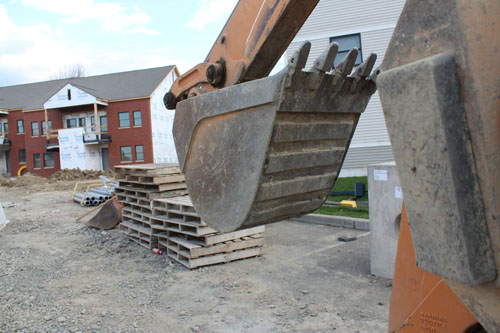IC builds stronger on-campus community

Photo by Alexis Lanza
With each incoming class, many colleges struggle to find a place to house everyone. This past fall, the University of Michigan had to deny housing to 180 students due to lack of space.
Though a relatively small school, Ithaca College is just as susceptible to problems such as those that Michigan faced. Students who choose housing last are inevitably placed in extended occupancy housing, so many freshmen make the transition to college in non-standard housing. Additionally, the desire for housing other than the traditional dorm room is sending upperclassmen off what is advertised as a residential campus.
To prepare for the fall 2012 semester, the college will expand freshman housing to West Tower and add 42 new apartments to the Circles complex.
These changes are largely due to IC 20/20, a comprehensive plan drafted in May 2011 to institute changes at the college within the next decade. One of many items proposed was to create a progression of housing similar to the academic progression, which, according to Residential Life director Bonnie Solt Prunty, would “create a more logical developmental sequence.”
The First Year Residential Experience, which will include West Tower in the fall, will serve as the starting point for the housing progression. Currently, the program includes East Tower and Boothroyd, Rowland and Tallcott in the Upper Quads, and focuses on a sense of community for first-year students to help them adjust to college life.
Roughly 600 first-year students participated in FYRE this past year, but even with the addition of West Tower, FYRE will need to continue to expand to accommodate all first-year students in the future. Solt Prunty said several models were proposed, but it is likely the program will extend into the Quads due to their centralized location.
In addition to bringing first-year students together, such a program would ensure they have housing at all. Because of a lack of standard rooms this past fall, about 50 students were housed in extended occupancy rooms, according to Solt Prunty’s reports. These were often study lounges converted into four-person rooms.
“We want to get away from that because we know that our first year students are in some ways our most vulnerable population,” Solt Prunty said. “It’s a difficult time of transition for them to start out with and then to put them in temporary housing on top of it is really not an ideal circumstance.”
Upperclassmen housing is also being added to the campus, as accommodations have been built for 168 students in the Circles apartment complex. The Circles property had space to add more buildings, and housing in the complex has typically been the highest demand. The additions were intended to draw upperclassmen back onto campus while freeing up traditional dorms for the underclassmen.
The current Circles apartments, which were constructed in 1989 as private housing not associated with the college, house between three and six students in single or double rooms. The new Circles, which are being constructed by local firm Integrated Acquisition and Development, are all four-person units with four single bedrooms and the same facilities as the original Circles.
In the future, Ithaca College plans to extend the housing progression to include a sophomore program. Rory Rothman, associate vice president for Student Affairs and Campus Life and administrative co-chair for the IC 20/20 Residential Models task force, said that the sophomore program will serve as part of students’ developmental transition and progression.
“In the sophomore year, the concept is to continue to grow the opportunities for sophomores,” Rothman said.
One would be topic-based housing in subjects that students can engage in, similar to the Sustainably Conscious Living and Outdoor Adventure RLCs offered now. The other would be closer to a sophomore version of the FYRE, including a sense of community that includes the Ithaca area as a whole, as well as opportunities they might explore as an upperclassman, such as study abroad.
Rothman stressed the program’s emphasis on “preparation to take the next step in their development toward independence and a readiness to take advantage of all the opportunities.”
Other plans in the works include a revised transfer student housing program. Currently, transfer students have their own RLC, which was started this past fall on the first floor of Terrace 11, and Solt Prunty said that the demand was actually too much to accommodate. Rather than making a mandatory program, the goal is to meet the needs of transfer students and be more committed to the uniqueness of the transfer transition.
Though housing on campus has generally been well homogenized, the plan for more progression-based housing was developed to help build a stronger community.
“The best practices in the field tell us that students, when they’re first-year students, do better when we house them together,” Smith-Schubart said. “We make sure that we’re targeting the type of programming and outreach that we do for their specific needs, so we’re moving in that direction as a campus.”
The new plans also enable the college to incorporate academics and civic engagement into the housing community to create a complex and interdisciplinary experience. These changes, according to Rothman, are an “effort to try to think of the student experience as a holistic experience.”
Amanda Hutchinson is a freshman journalism major who will pitch a tent on the Quad over living in Terraces. Email her at ahutchi2[at]ithaca[dot]edu.
